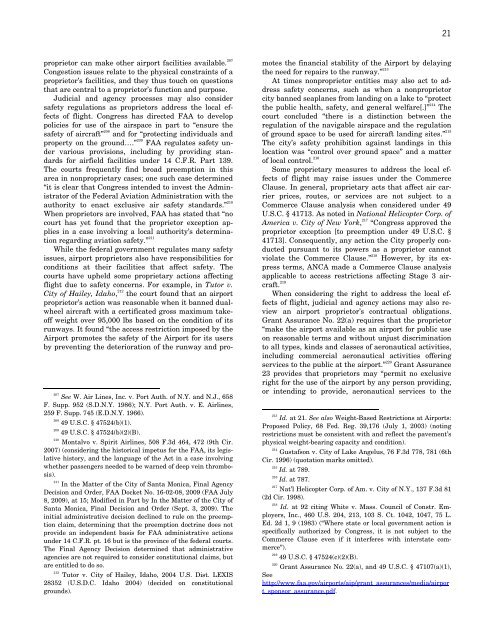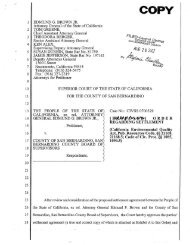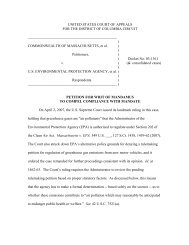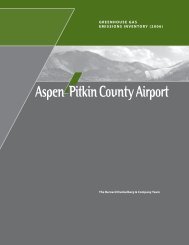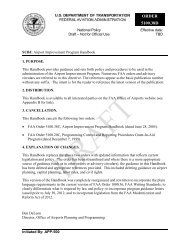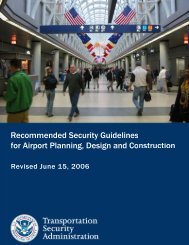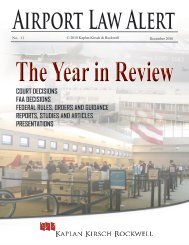ACRP Legal Research Digest 10
ACRP Legal Research Digest 10
ACRP Legal Research Digest 10
Create successful ePaper yourself
Turn your PDF publications into a flip-book with our unique Google optimized e-Paper software.
21<br />
proprietor can make other airport facilities available. 207<br />
Congestion issues relate to the physical constraints of a<br />
proprietor’s facilities, and they thus touch on questions<br />
that are central to a proprietor’s function and purpose.<br />
Judicial and agency processes may also consider<br />
safety regulations as proprietors address the local effects<br />
of flight. Congress has directed FAA to develop<br />
policies for use of the airspace in part to “ensure the<br />
safety of aircraft” 208<br />
and for “protecting individuals and<br />
property on the ground….” 209<br />
FAA regulates safety under<br />
various provisions, including by providing standards<br />
for airfield facilities under 14 C.F.R. Part 139.<br />
The courts frequently find broad preemption in this<br />
area in nonproprietary cases; one such case determined<br />
“it is clear that Congress intended to invest the Administrator<br />
of the Federal Aviation Administration with the<br />
authority to enact exclusive air safety standards.” 2<strong>10</strong><br />
When proprietors are involved, FAA has stated that “no<br />
court has yet found that the proprietor exception applies<br />
in a case involving a local authority’s determination<br />
regarding aviation safety.” 211<br />
While the federal government regulates many safety<br />
issues, airport proprietors also have responsibilities for<br />
conditions at their facilities that affect safety. The<br />
courts have upheld some proprietary actions affecting<br />
flight due to safety concerns. For example, in Tutor v.<br />
City of Hailey, Idaho, 212 the court found that an airport<br />
proprietor’s action was reasonable when it banned dualwheel<br />
aircraft with a certificated gross maximum takeoff<br />
weight over 95,000 lbs based on the condition of its<br />
runways. It found “the access restriction imposed by the<br />
Airport promotes the safety of the Airport for its users<br />
by preventing the deterioration of the runway and pro-<br />
207<br />
See W. Air Lines, Inc. v. Port Auth. of N.Y. and N.J., 658<br />
F. Supp. 952 (S.D.N.Y. 1986); N.Y. Port Auth. v. E. Airlines,<br />
259 F. Supp. 745 (E.D.N.Y. 1966).<br />
208<br />
49 U.S.C. § 47524(b)(1).<br />
209<br />
49 U.S.C. § 47524(b)(2)(B).<br />
2<strong>10</strong><br />
Montalvo v. Spirit Airlines, 508 F.3d 464, 472 (9th Cir.<br />
2007) (considering the historical impetus for the FAA, its legislative<br />
history, and the language of the Act in a case involving<br />
whether passengers needed to be warned of deep vein thrombosis).<br />
211 In the Matter of the City of Santa Monica, Final Agency<br />
Decision and Order, FAA Docket No. 16-02-08, 2009 (FAA July<br />
8, 2009), at 15; Modified in Part by In the Matter of the City of<br />
Santa Monica, Final Decision and Order (Sept. 3, 2009). The<br />
initial administrative decision declined to rule on the preemption<br />
claim, determining that the preemption doctrine does not<br />
provide an independent basis for FAA administrative actions<br />
under 14 C.F.R. pt. 16 but is the province of the federal courts.<br />
The Final Agency Decision determined that administrative<br />
agencies are not required to consider constitutional claims, but<br />
are entitled to do so.<br />
212<br />
Tutor v. City of Hailey, Idaho, 2004 U.S. Dist. LEXIS<br />
28352 (U.S.D.C. Idaho 2004) (decided on constitutional<br />
grounds).<br />
motes the financial stability of the Airport by delaying<br />
the need for repairs to the runway.” 213<br />
At times nonproprietor entities may also act to address<br />
safety concerns, such as when a nonproprietor<br />
city banned seaplanes from landing on a lake to “protect<br />
the public health, safety, and general welfare[.]” 214<br />
The<br />
court concluded “there is a distinction between the<br />
regulation of the navigable airspace and the regulation<br />
of ground space to be used for aircraft landing sites.” 215<br />
The city’s safety prohibition against landings in this<br />
location was “control over ground space” and a matter<br />
of local control. 216<br />
Some proprietary measures to address the local effects<br />
of flight may raise issues under the Commerce<br />
Clause. In general, proprietary acts that affect air carrier<br />
prices, routes, or services are not subject to a<br />
Commerce Clause analysis when considered under 49<br />
U.S.C. § 41713. As noted in National Helicopter Corp. of<br />
America v. City of New York, 217 “Congress approved the<br />
proprietor exception [to preemption under 49 U.S.C. §<br />
41713]. Consequently, any action the City properly conducted<br />
pursuant to its powers as a proprietor cannot<br />
violate the Commerce Clause.” 218<br />
However, by its express<br />
terms, ANCA made a Commerce Clause analysis<br />
applicable to access restrictions affecting Stage 3 aircraft.<br />
219<br />
When considering the right to address the local effects<br />
of flight, judicial and agency actions may also review<br />
an airport proprietor’s contractual obligations.<br />
Grant Assurance No. 22(a) requires that the proprietor<br />
“make the airport available as an airport for public use<br />
on reasonable terms and without unjust discrimination<br />
to all types, kinds and classes of aeronautical activities,<br />
including commercial aeronautical activities offering<br />
services to the public at the airport.” 220 Grant Assurance<br />
23 provides that proprietors may “permit no exclusive<br />
right for the use of the airport by any person providing,<br />
or intending to provide, aeronautical services to the<br />
213<br />
Id. at 21. See also Weight-Based Restrictions at Airports:<br />
Proposed Policy, 68 Fed. Reg. 39,176 (July 1, 2003) (noting<br />
restrictions must be consistent with and reflect the pavement’s<br />
physical weight-bearing capacity and condition).<br />
214<br />
Gustafson v. City of Lake Angelus, 76 F.3d 778, 781 (6th<br />
Cir. 1996) (quotation marks omitted).<br />
215<br />
Id. at 789.<br />
216<br />
Id. at 787.<br />
217<br />
Nat’l Helicopter Corp. of Am. v. City of N.Y., 137 F.3d 81<br />
(2d Cir. 1998).<br />
218<br />
Id. at 92 citing White v. Mass. Council of Constr. Employers,<br />
Inc., 460 U.S. 204, 213, <strong>10</strong>3 S. Ct. <strong>10</strong>42, <strong>10</strong>47, 75 L.<br />
Ed. 2d 1, 9 (1983) (“Where state or local government action is<br />
specifically authorized by Congress, it is not subject to the<br />
Commerce Clause even if it interferes with interstate commerce”).<br />
219<br />
49 U.S.C. § 47524(c)(2)(B).<br />
220<br />
Grant Assurance No. 22(a), and 49 U.S.C. § 47<strong>10</strong>7(a)(1),<br />
See<br />
http://www.faa.gov/airports/aip/grant_assurances/media/airpor<br />
t_sponsor_assurance.pdf.


